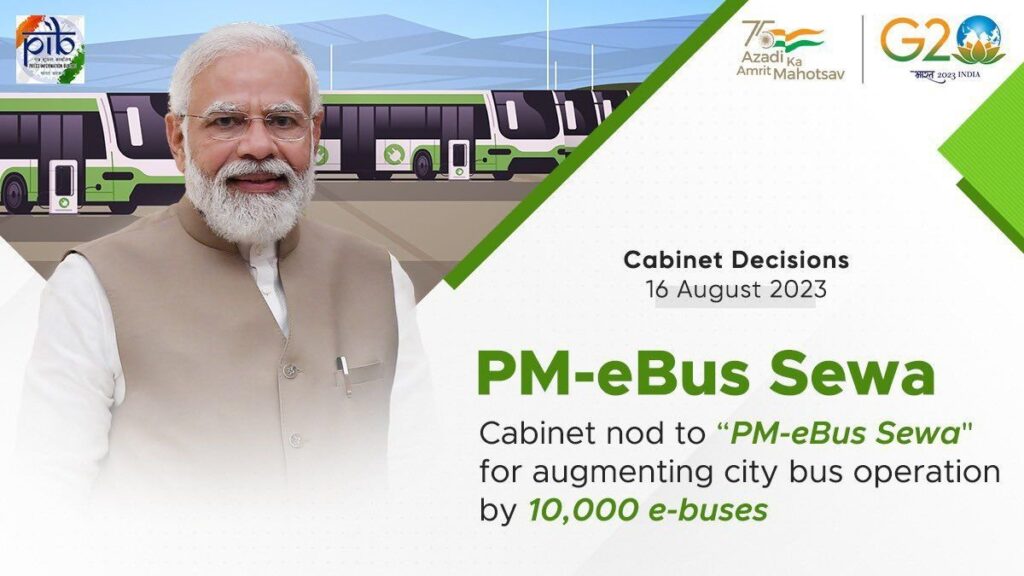Cabinet nod for 10,000 electric buses in 169 cities
Context
The Union Cabinet adopted a plan on Wednesday to increase the number of city bus services nationwide by 10,000 e-buses and to strengthen urban infrastructure as part of green mobility measures, with an emphasis on cities without organized bus services.
What is the PM e-bus Sewa scheme?
- A Public Private Partnership (PPP) model will be used to deploy 10,000 electric buses as part of the “PM-eBus Sewa” program, which is led by Prime Minister Shri Narendra Modi.
- The project is expected to cost Rs. 57,613 crore in total, of which Rs. 20,000 crore will come from the central government.
- For ten years, the program will provide financial support for bus operations.
What are the characteristics of PM e-bus Sewa?
- Coverage and Priority:
-
-
- According to the 2011 census, the program is focused on cities with a population of three lakh people or more.
- This covers all Union Territory capital cities, the North Eastern region, and the Hill States.
- Cities without organized bus services will be given preference.
-
- Employment Creation:
-
- By deploying roughly 10,000 buses for city bus operations, the plan is expected to create 45,000 to 55,000 direct jobs.
How are the Sections of the Plan divided?
- Enhancing City Bus Services in Segment A (169 Cities)
-
-
- In this section, 10,000 e-buses will be added to city bus operations as part of a PPP model.
- The building of power infrastructure for e-buses and depot development and improvements are examples of infrastructure assistance.
-
- Green Urban Mobility Initiatives in Segment B (181 cities)
-
- This component of the plan focuses on environmentally friendly projects such as charging infrastructure, automated fare collection systems, multimodal interchanges, bus priority measures, and more.
- Operation and Support: States and Cities are in charge of managing bus services and paying bus drivers.

What are the Benefits of the nation?
- Environment-friendly Transport:
-
-
- The launch of 10,000 electric buses encourages clean, green transportation.
- Compared to conventional diesel-powered buses, electric buses have much lower emissions, which contributes to lowering air pollution and carbon emissions.
- Reduced Pollution and Improved Air Quality:
- Electric buses have no tailpipe emissions, which helps to enhance the air quality in urban areas while reducing pollution.
- Public health will benefit from this pollution reduction, especially in densely populated areas.
-
- Climate Change Mitigation:
-
-
- By lowering greenhouse gas emissions, the switch to electric mobility is in line with the nation’s climate goals.
- Increased use of electric buses can help countries and other nations meet their climate change mitigation obligations.
-
- Job Creation:
-
-
- The introduction of around 10,000 electric buses is anticipated to result in the creation of 45,000 to 55,000 direct jobs.
- Bus drivers to maintenance workers will all have job opportunities, which will support social and economic development.
-
- Economic Growth and Local Development:
-
- The plan’s emphasis on the expansion of public transportation infrastructure and service delivery can boost economic activity.
- The development of jobs and an increase in the use of public transportation may have a favourable domino effect on nearby services and businesses.
What is the role between State and Centre in this scheme?
- The collaboration between the Central and state governments emphasizes a planned strategy for the growth of public transportation.
- States can adapt the services to their specific needs while still receiving funding from the Central government.
Conclusion:
In conclusion, the Union Cabinet’s plan focuses on boosting urban infrastructure and extending city bus services using electric buses. This program is anticipated to improve public transit, reduce pollution, create jobs, and boost the economy across several parts of India.




